Have you ever craved a meal that felt like a hug in a bowl? That’s exactly how I feel every time I cook my favorite homemade Tex-Mex soup. Inspired by the rich, smoky flavors of the Southwest, this flavorful soup recipe has become a staple in my household. Whether it’s a crisp fall evening or a chilly winter’s day, this aromatic blend of spices and fresh ingredients always warms me from the inside out.
This Southwestern Soup with Smoky Tex-Mex Flavors Recipe is not just about nourishment—it’s about creating memories over a steaming bowl of comfort. From hearty beans to vibrant veggies, each spoonful offers a burst of flavors that bring a smile to my face. As I stand over the stove, infusing the broth with cumin, chili powder, and the smoky kick of chipotle peppers, I remember the dinners shared with loved ones, the laughter echoing in the kitchen, and the satisfaction of serving something truly delicious and wholesome.
And the best part? This recipe is incredibly versatile. Whether I’m in the mood for chicken, ground beef, or a vegetarian delight, this Southwestern concoction adapts beautifully to my cravings. It’s more than just a meal; it’s an experience, a journey through the vibrant spices and textures that define Tex-Mex cuisine.
In a world that’s always rushing, taking 40 minutes to cook something with love can be incredibly grounding. Sautéing aromatics, simmering broth, and tasting until that perfect balance is achieved—each step is an act of love, an invitation to enjoy life’s simple pleasures. So, let’s dive into this delectable adventure and bring a little southwestern sunshine to your table.
Introduction to My Favorite Southwestern Soup
One of my all-time favorite dishes to prepare is a hearty, flavorful Southwestern soup. This recipe truly stands out because of its unique combination of smoky flavors and rich textures. By incorporating ingredients such as chipotle peppers, black beans, and sweet corn, this soup delivers an explosion of Tex-Mex flavors that are both comforting and invigorating. Perfect for any occasion, it’s a culinary delight that brings the soul of the Southwest straight to your kitchen.
What Makes It Special
There are several elements that make this spicy Southwestern soup extraordinary. First, the use of authentic spices like cumin, smoked paprika, and chili powder creates deep, complex flavors. Additionally, the heartiness of black beans and the subtle sweetness of baby corn provide a delightful contrast in each spoonful. Let’s not forget the aromatic blend of sautéed onions, garlic, and jalapenos that sets the stage for this flavorful feast. Here’s an outline of the key features:
- Authentic Tex-Mex flavors from a blend of traditional spices.
- Rich, smoky undertones from chipotle peppers.
- Hearty texture with black beans and sweet corn.
- Aromatics like onions, garlic, and jalapenos for a robust base.
A Brief History of Southwestern Flavors
Southwestern flavors have a rich and diverse history, influenced by both Native American and Hispanic culinary traditions. These contributions have melded together to create a distinctive taste profile characterized by bold spices, vibrant ingredients, and a comforting warmth. Ingredients like chili peppers, beans, and cilantro are staples in this cuisine, contributing to many beloved dishes. This flavorful fusion is more than just food; it’s a celebration of cultural heritage and a testament to the art of cooking.
Key Ingredients for My Soup
Creating a delectable fresh ingredients Tex-Mex soup requires careful selection of key spicy ingredients and protein choices that lend both richness and flavor to the dish. Each component plays a crucial role in crafting a memorable soup experience.
Fresh Vegetables and Their Benefits
Utilizing fresh ingredients in Tex-Mex soup is essential for achieving the vibrant, wholesome flavors unique to this cuisine. I often include sweet potatoes, corn, and tomatoes. These vegetables not only enhance the taste but are also packed with vitamins and fiber, making the soup both nutritious and delicious.
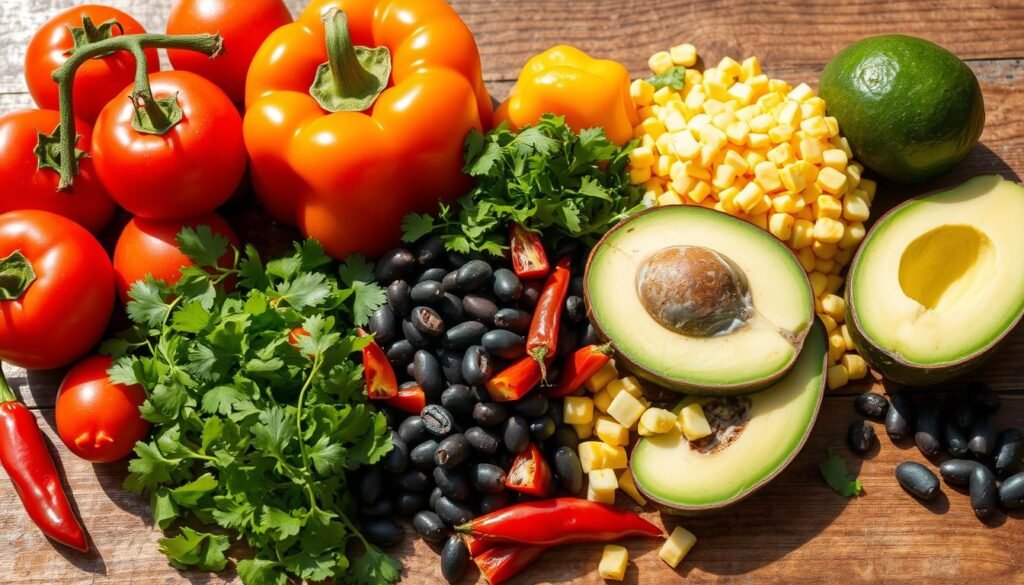
The Importance of Spices
Spices are at the heart of any good Tex-Mex recipe. Key spicy ingredients like cumin, smoked paprika, and chili powder bring the authentic Southwestern taste to my soup. These spices are crucial not just for their flavor but also for the aromatic experience they provide, enveloping your senses in the essence of the Southwest.
Protein Choices for Richness
For a truly satisfying meal, a protein-rich soup is a must. Including options like chicken or beef adds depth and richness to the dish, making it more filling. Black beans are another excellent choice, offering both protein and fiber. This blend of proteins ensures the soup is hearty enough to serve as a standalone meal.
Preparing the Base for the Soup
Creating a delicious Southwestern soup lies in building a solid foundation by using quality ingredients and meticulous preparation techniques. This includes the essential steps of sautéing vegetables and integrating a flavorful broth, ensuring that every bite is a delight.
Sautéing Aromatics
The first step in building the soup base involves sautéing vegetables. Start by heating one tablespoon of olive oil and one tablespoon of butter in a large pot over medium heat. Add one medium sweet yellow onion, two celery stalks, one medium red bell pepper, three medium carrots, four cloves of garlic, and one jalapeño – all coarsely chopped. These aromatic vegetables are the heart and soul of this dish.
Sauté the aromatics until they become soft and fragrant, approximately 5-7 minutes. The combination of onion, garlic, celery, and bell pepper serves as the flavor backbone for the soup, releasing their natural oils and creating a rich, aromatic base.
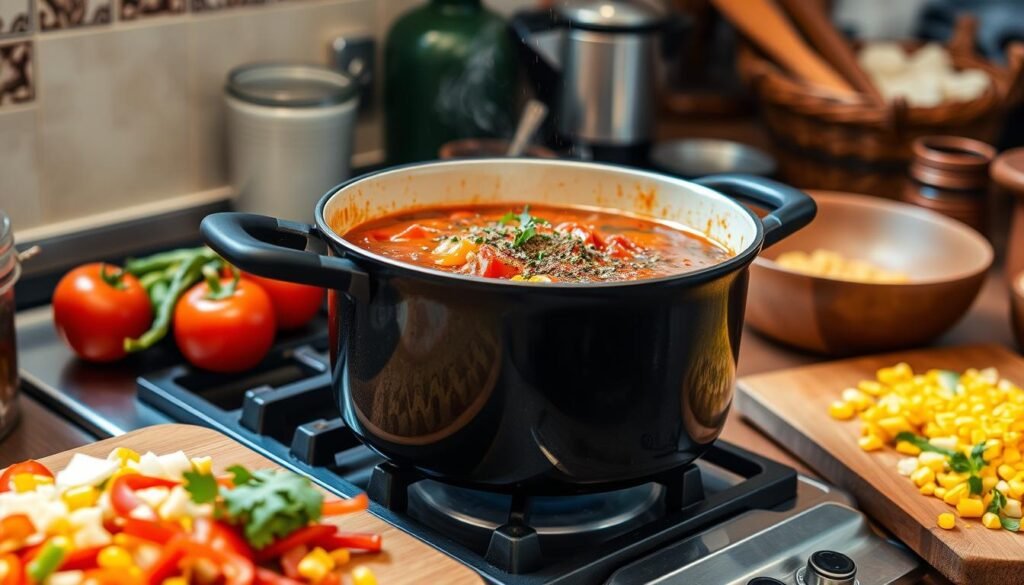
Building Flavor with Broth
Once the vegetables are softened, it’s time to focus on building a flavorful broth. Pour in six cups of low-sodium chicken broth to the pot. This essential step ensures the soup has a deeply savory taste. The broth absorbs the flavors from the sautéed vegetables and the added spices, which include one tablespoon of dried oregano, two teaspoons of ground coriander, one teaspoon of cumin, one teaspoon of smoked paprika, and one teaspoon of Ancho chili powder.
Allow the mixture to simmer for about 25 minutes, stirring occasionally, so all the ingredients meld together harmoniously. The combination of building soup base and sautéing vegetables ensures the final product is profoundly flavorful. With these steps, you are all set to create a mouth-watering soup that your friends and family will rave about.
Adding Smoky Tex-Mex Flavor
One of the best parts of making a Tex-Mex soup is the distinctive smoky taste that forms its backbone. Achieving this smoky soup recipe involves some key ingredients that truly define its flavor profile.
Incorporating Chipotle Peppers
Chipotle peppers are a fundamental ingredient in my smoky soup recipe. These dried and smoked jalapeños bring not only a smoky depth but also a desirable kick of heat to the dish. I always use them generously to enhance the overall taste. Chipotle peppers add an exciting complexity that makes each spoonful rich and flavorful.
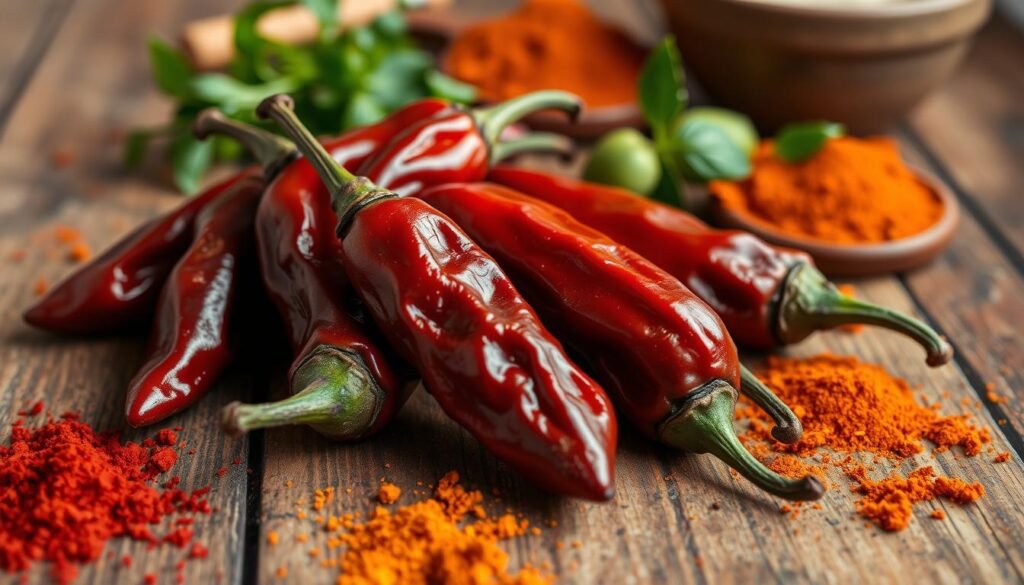
The Role of Smoked Paprika
Another essential component is smoked paprika. This spice contributes a subtle but significant smoky flavor and adds a beautiful rich color to the soup. Unlike regular paprika, smoked paprika brings out a woodsy aroma, which pairs perfectly with the heat from the chipotle peppers. Together, they create a harmonious balance where neither overpowers the other, making the soup both vibrant and enjoyable.
Choosing the Right Beans
When it comes to creating a perfect Southwestern soup, selecting the correct beans is crucial. Different bean varieties offer unique flavors and textures to your dish, so it’s essential to choose wisely. Most traditional Southwestern soups feature black beans, pinto beans, or a combination of both for optimal heartiness and flavor depth.
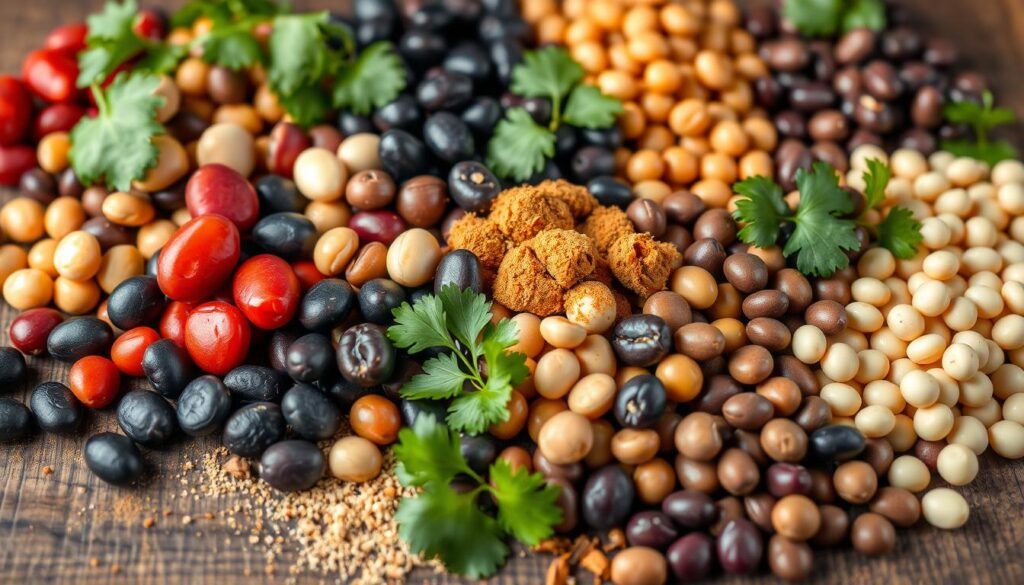
Varieties to Consider
Black beans and pinto beans are the cornerstone of any hearty soup beans, especially in Southwestern and Tex-Mex cuisine. Black beans, known for their slightly sweet flavor and creamy texture, absorb the smoky and spicy notes exceptionally well. Pinto beans, on the other hand, are softer and often used in refried beans, but they work equally well in a broth-based soup. I frequently explore combinations of these bean varieties to add complexity to my soups.
Cooking Dried Beans vs. Canned
The debate between using dried vs canned beans is common among home cooks. Dried beans require more preparation, including soaking and longer cooking times, but they often have a fresher flavor and less sodium. However, canned beans are incredibly convenient and significantly reduce the prep time, making them a great choice for quick meals. I find that the quality of the soup doesn’t suffer much if you opt for canned beans, as the hearty soup beans and rich spices can still shine through. For a detailed black bean soup recipe, feel free to check out this link for inspiration.
Tips for Cooking the Perfect Soup
Creating a delicious and memorable soup requires attention to detail and efficient cooking tips. By managing your time wisely and focusing on developing soup flavors, you can achieve perfect soup cooking every time.
Time Management in the Kitchen
Time management is crucial for the perfect soup cooking experience. I like to begin by preparing all my ingredients in advance. This means having my garlic minced, my vegetables chopped, and my seasonings measured out before I even turn on the stove. This not only saves time but also ensures that I can focus on each step without having to pause and prep more ingredients.
Ensuring efficient cooking tips are part of the process is essential. For instance, while the aromatics sauté, I make sure my broth is readily available and that the shredded chicken is within arm’s reach. Timing how long to cook each component, such as adding frozen corn or diced green chiles, is also key to ensuring every ingredient is perfectly cooked.
Flavor Development
Developing soup flavors is about layering ingredients and allowing them to meld together beautifully. I begin by sautéing aromatics such as garlic and onions in a tablespoon of canola oil. This initial step helps build a solid base of flavor. Adding spices like chili powder, dried oregano, and ground cumin at this stage intensifies the flavors.
Simmering is where the magic happens. Allowing the soup to gently simmer with ingredients like diced fire-roasted tomatoes, black beans, and a mix of chicken stock brings everything together. Gradually adding salt and tasting the soup as it simmers helps balance the flavors perfectly.
Efficient cooking tips include making sure to use low-sodium chicken stock, so you have better control over the saltiness. Another key aspect of developing soup flavors is incorporating proteins like cooked, shredded chicken or even switching it up with ground beef or shredded pork for variety. This not only enriches the soup but also offers different taste profiles.
Remember, the noodles will absorb quite a bit of the cooking liquid, so be prepared to add additional broth as needed to maintain the desired consistency. Perfect soup cooking is all about paying attention to these details, making adjustments, and being patient as the flavors meld together to create a delicious and heartwarming dish.
Customizing the Recipe
One of the best aspects of creating a customizable Tex-Mex soup is its versatility in accommodating different dietary preferences. Whether you prefer a spicy kick or need a gluten-free option, there are several ways to tailor this recipe to suit your needs.
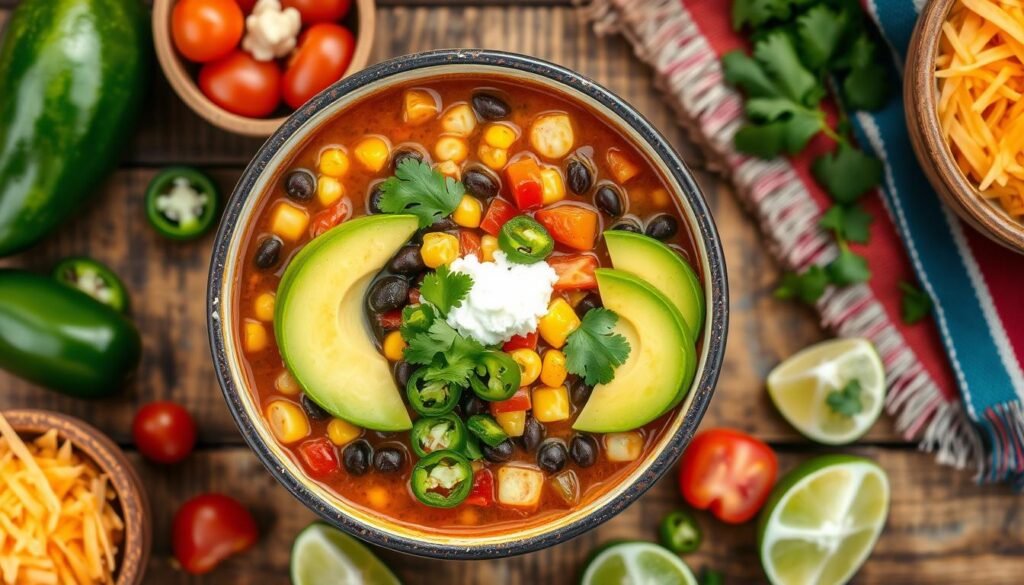
Spice Adjustments for Your Taste
The beauty of a customizable Tex-Mex soup is its adaptability to your spice tolerance. You can easily adjust the spice level by varying the amount of chipotle peppers and smoked paprika. For those who relish a fiery flavor, adding extra jalapeños can elevate the heat. On the other hand, opting for milder peppers like Anaheim can make the dish more palatable for those with sensitive taste buds. Remember, it’s all about finding that perfect balance to make every spoonful delightful.
Vegetarian and Vegan Adaptations
Transforming this soup into a vegan Tex-Mex recipe is straightforward. Substitute the meat with hearty plant-based proteins, such as extra beans or tofu. Utilize vegetable broth in place of chicken broth to maintain that rich depth of flavor. This not only makes it vegan but also an excellent choice for vegetarians who want to enjoy a hearty meal without compromising on taste.
Gluten-Free Options
Creating a gluten-free southwestern soup is easier than you might think, as many of the core ingredients do not contain gluten inherently. However, it’s essential to ensure that all packaged ingredients, like broth and seasonings, are certified gluten-free. This careful attention guarantees that those with gluten sensitivities can savor every bite without worry.
Serving Suggestions
When it comes to serving Southwestern soup, the right accompaniments and garnishes can elevate your meal from ordinary to extraordinary. Here are my favorite ideas that will make your dining experience unforgettable.
Pairing with Cornbread or Tortillas
One of the most delightful southwestern soup pairing options is serving it alongside cornbread or tortillas. The mild flavors of these sides balance the spicy notes of the soup perfectly. I like to use homemade cornbread, which is slightly sweet and complements the smoky flavors of the soup beautifully. Alternatively, freshly made corn tortillas provide a delightful, chewy texture that contrasts with the soup’s ingredients.

You can even cut the tortillas into strips and fry them for added crunch, making every bite more exciting.
Garnishing Ideas
When it comes to soup garnishing, the possibilities are endless. Garnishes not only add visual appeal but also enhance the flavor and provide a cooling contrast to the spicy soup. Here are a few of my favorite garnishing ideas:
- Cilantro: Freshly chopped cilantro adds a burst of freshness and a hint of citrus.
- Avocado: Creamy avocado slices bring a rich texture that pairs well with the soup’s flavors.
- Sour Cream: A dollop of sour cream gives a cooling effect, balancing the spice.
- Lime Juice: A squeeze of fresh lime juice brightens up the overall taste.
These garnishes not only make your southwestern soup pairing look more appealing but also add layers of flavor that make each spoonful delightful.
Storing Leftovers
After enjoying a delicious bowl of Southwestern soup, you might find yourself with some leftovers. It’s important to ensure they are stored properly to maintain both flavor and safety. Let’s discuss some effective refrigeration tips and techniques for freezing soup.
Refrigeration Tips
When it comes to storing soup, cooling it properly before refrigeration is crucial. Make sure the soup cools down to room temperature before transferring it to the refrigerator. Place the leftovers in airtight containers to prevent any odors from seeping in and to maintain freshness. Your refrigerated soup can stay good for up to 5 days. These refrigeration tips will help ensure that your meal retains its rich texture and robust flavors.
Freezing for Later Enjoyment
If you need to keep your soup for a longer period, freezing is your best option. Divide the soup into portions and use sturdy, airtight containers or heavy-duty freezer bags. When freezing soup, allow some space at the top of the container for the soup to expand. Properly frozen, the soup can last up to 6 months. When you’re ready to enjoy it, thaw the soup in the refrigerator overnight and reheat it on the stove or in the microwave. By mastering these tips for freezing soup, you can always have a quick and comforting meal ready for future busy days.
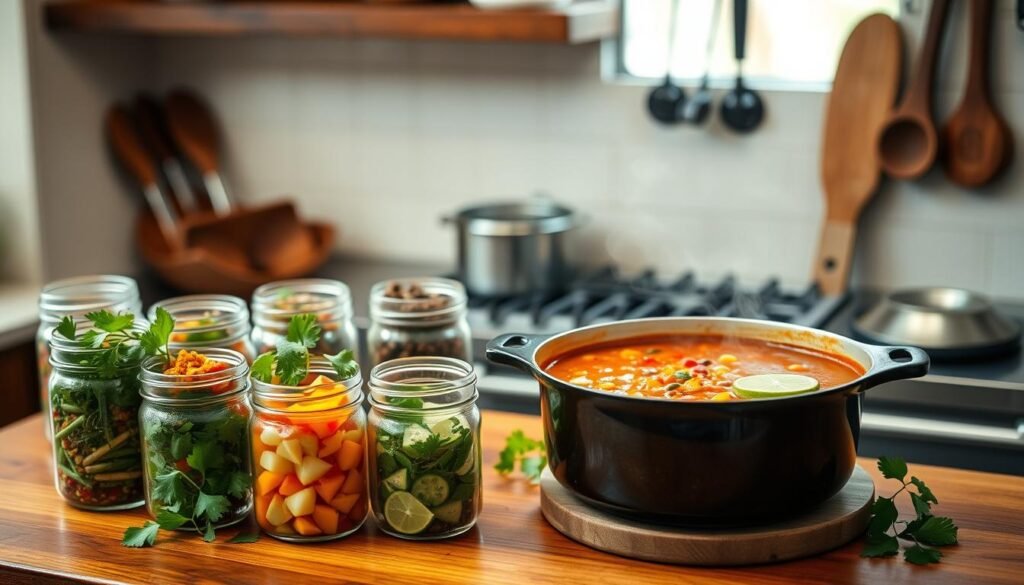
Nutritional Benefits of the Ingredients
My Southwestern Soup is not just packed with flavors, it’s also brimming with healthy ingredients that provide numerous nutritional benefits. A look at the key components reveals how each element contributes to a wholesome, balanced diet.
A Closer Look at Beans and Legumes
Beans and legumes, such as black beans, are an excellent source of protein and fiber. Including beans in diet helps to maintain heart health, aid in digestion, and keep blood sugar levels stable due to their high fiber content. Additionally, they are low in fat and packed with essential vitamins and minerals.
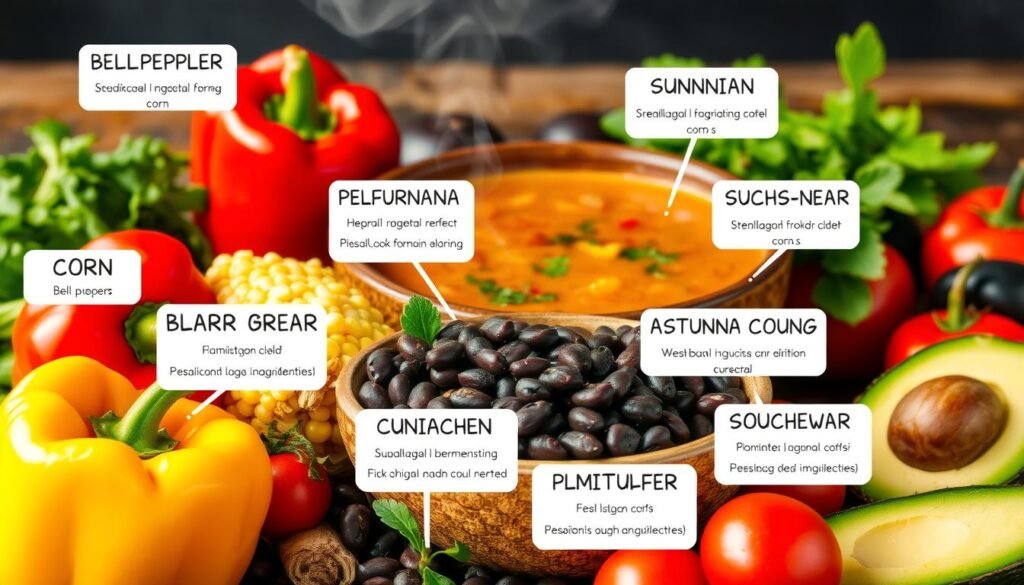
Health Perks of Spices
Spices are not only about enriching flavors; they carry significant health benefits too. Cumin and chili powder, commonly used in Southwestern soups, are rich in antioxidants that combat inflammation and reduce the risk of chronic diseases. These spices health benefits include boosting the immune system and improving metabolism, making them an integral part of my soup recipe.
The combination of healthy ingredients and spices in my Southwestern Soup ensures you get the nutritional benefits while enjoying a delicious meal. With 21g of protein, 7g of fiber, and only 252 calories per serving, this soup stands out as a nutritious option for anyone looking to maintain a balanced diet.
Common Mistakes to Avoid
Cooking a flavorful Southwestern soup can be incredibly rewarding, but even seasoned cooks can fall prey to common cooking mistakes. Understanding how to avoid overcooking while properly flavor balancing can elevate your soup to new heights. Let’s delve into some prevalent pitfalls and how to steer clear of them.
Overcooking vs. Under-flavoring
One of the most frequent common cooking mistakes is overcooking, which can turn your fresh vegetables into mush and make proteins tough. On the flip side, under-flavoring results in a bland soup that lacks the rich, smoky Tex-Mex notes you’re aiming for. The trick here is precision. Utilize your timer and taste test as you go. Adding spices incrementally helps in flavor balancing and prevents overpowering any single ingredient.
Ingredient Substitutions That Don’t Work
While it can be tempting to swap out ingredients based on availability or dietary needs, some ingredient substitutions just don’t deliver the desired results. For instance, substituting smoked paprika with regular paprika will strip away the essential smoky flavor, and switching chicken broth for vegetable broth might dilute the richness. Always consider the flavor profiles and intended texture of your soup when making changes to ensure a harmonious blend of tastes.
Creating a Meal Prep Plan
One of the best ways to ensure you have delicious and nutritious meals throughout the week is to engage in efficient meal prep for soup. By preparing ingredients and leveraging batch cooking techniques, you can enjoy homemade soup without spending excessive time in the kitchen.
How to Prepare Ingredients in Advance
Preparing ingredients ahead of time can significantly streamline your cooking process. For instance, chopping vegetables, measuring spices, and readying protein choices can save you substantial time.
- Chopping Vegetables: Pre-chop onions, bell peppers, jalapenos, and garlic for easy addition to your soup base.
- Measuring Spices: Mix your taco seasoning ingredients, including chili powder, ground cumin, and smoked paprika, and store them in an airtight container.
- Protein Prep: Dice chicken breasts or measure out beans in advance to simplify your cooking steps.
Batch Cooking for Busy Days
Batch cooking can be a lifesaver on hectic weekdays. Doubling or tripling your soup recipes allows you to store portions for future meals.
- Cooking Large Quantities: Cook the taco soup recipe, which yields 10 cups, in one go. Store it in airtight containers for up to 5 days in the fridge or freeze for up to 6 months.
- Heating and Serving: Reheat individual portions on the stovetop or microwave as needed. Add toppings like diced avocado, lime wedges, and tortilla strips to enhance flavor.
By consistently practicing these meal prep for soup strategies, from preparing ingredients to batch cooking, you can ensure that nutritious and flavorful meals are always within reach, even on your busiest days.
Flavor Enhancements
Elevate your soup game by introducing a few simple, yet impactful ingredients. Enhancing soup flavor can truly transform your dish from good to great. Here are two of my favorite techniques to bring out the best in any soup, especially a Southwestern-inspired one.
Adding Citrus Zest
One of the easiest ways to brighten up your soup is by adding citrus zest. A touch of lemon or lime zest can cut through the richness with a hint of acidity, bringing a fresh dimension to the dish. To incorporate this, zest the citrus directly over the soup pot just before serving. This technique can be especially effective for enhancing soup flavor when used alongside smoky Tex-Mex ingredients. The pop of citrus zest can create a delightful contrast that will make every spoonful more exciting.
Using Fresh Herbs
Nothing beats the vibrant taste of fresh herbs in soup. They can be a game-changer, particularly when added towards the end of the cooking process. Fresh herbs like cilantro, parsley, or thyme can preserve their flavor and freshness, enhancing the soup’s overall taste profile. When I prepare a Southwestern soup, I love to stir in chopped cilantro just before I take the pot off the heat. This final touch not only enhances the flavor but also provides a beautiful, aromatic finish to the dish.
Hosting a Soup Night
Hosting a soup night can be an exciting way to bring together family and friends. A great soup night idea is to theme the evening around Southwestern cuisine, which offers rich, smoky Tex-Mex flavors. From the decor to the menu, a themed dinner can transform a simple gathering into an unforgettable experience.
Ideas for a Themed Dinner
To create the perfect atmosphere, consider incorporating Southwestern elements like cactus-centerpieces, colorful tablecloths, and rustic décor. These small touches can make your guests feel like they’re dining in the heart of the Southwest. While the Southwestern Soup is the star of the evening, don’t forget to include easy appetizers that align with your theme. Think mini quesadillas, corn salsa, and spicy dips to keep everyone satisfied until the main course.
Pairing Drinks with Southwestern Soup
When it comes to drink pairings, you want beverages that complement the bold flavors of the Southwestern Soup. Light beers are an excellent choice; they won’t overpower the dish and offer a refreshing counterbalance to the spices. Another fantastic option is margaritas, which can range from classic lime to more adventurous flavors like mango or jalapeño, adding a fun twist to your soup night ideas. For a non-alcoholic option, consider serving iced tea with a splash of citrus for a crisp, soothing drink.
Remember, the key to a successful soup night is not just the food, but the overall experience. By thoughtfully crafting your menu and atmosphere through strategic soup night ideas and themed dinner elements, you’ll create a memorable event that everyone will rave about long after the last bowl is emptied.
Conclusion and Enjoyment
As I reflect on my adventures in the kitchen, cooking this Southwestern soup has truly been a rewarding experience. The marriage of smoky Tex-Mex flavors with fresh, wholesome ingredients made for a comforting and satisfying meal. Each step, from sautéing aromatics to simmering the soup, enhanced my understanding of flavor development and time management in the kitchen. These cooking reflections have provided invaluable insights that will guide me in future preparations, ensuring that each pot of soup is even more delightful than the last.
Reflecting on My Cooking Experience
Experimenting with ingredients such as chipotle peppers and smoked paprika added layers of complexity and richness to my soup. I found that selecting the right beans and balancing spices were crucial to achieving the perfect blend. This experience not only refined my culinary skills but also deepened my appreciation for the art of cooking. My reflections on this journey have highlighted the importance of personalization, allowing me to make adjustments that cater to my taste preferences and dietary needs.
Inviting Friends and Family to Join
Sharing homemade soup with friends and family turns a simple meal into a joyous occasion. The inviting aroma and hearty flavors bring people together, creating a warm and welcoming atmosphere. Whether paired with cornbread, tortillas, or enjoyed on its own, this soup is perfect for gatherings. Inviting loved ones to partake in the meal fosters a sense of community and togetherness, turning an otherwise ordinary day into a memorable event. By embracing the joy of sharing meals, I am not only nourishing bodies but also nurturing relationships.
With these cooking reflections in mind, I encourage you to explore the fun of enjoying homemade soup with those you hold dear. Dive into the experience, savor every moment, and let the flavors speak for themselves. Here’s to many more delicious bowls shared with friends and family!
